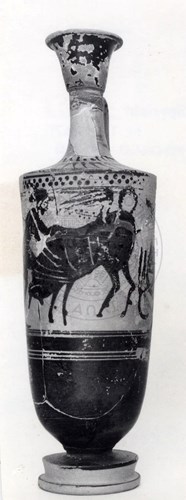The Theban Kabiroi were two deities associated with Dionysus. They were introduced by settlers (probably Greek) who arrived in the countryside west of Thebes in Boeotia in the eighth or seventh century BCE. The settlers maintained ownership of the Kabirion and the mysteries associated with the sanctuary until the fourth century BCE, even though their land had long been incorporated into Thebes. Like Eleusis and Samothrace, the Theban Kaborion was open to all (men and women, locals, and foreigners). According to Pausanias, Demeter entrusted two Kabeiraians (Prometheus and his son Aitnaios) with a secret gift (Pausanias refused to reveal what it was) that formed the core of the celebration. However, the Kabiroi could be vengeful. When some Persian soldiers slipped into the sanctuary in search of loot or from sheer impiety, the Kabiroi drove them mad and forced them to throw themselves off cliffs and into the sea. A similar fate awaited the soldiers of Alexander the Great who entered the sanctuary, only to be struck by lightning.
The sanctuary was about six kilometres west of Thebes among low hills. The site was selected because of a natural rock formation that served as a direct connection with the underground gods (the sanctuary of Demeter at Eleusis was also found next to the Mirthless Rock at the foot of a rocky acropolis). The Theban Kabirion lacked a telesterion. The initiation took place out of doors around the rock and in the theatre. There was a college of two hereditary priests who served for life and two or three Kabiriarchai who served as public officials. Twelve paragogeies may have functioned as mystagogoi or may have been appointed to collect an entrance fee from the initiates (numerous entrance tokens have been found in the Kabirion). The site underwent significant alterations as part of increasingly elaborate building programmes until the fourth century CE.
The deities worshipped at the Theban Kabirion were Kabiros and his son Pais, a mother goddess, and her consort. Kabiros received most of the dedications (hundreds of terracotta figurines of animals and humans, as well as lead and bronze statuettes representing bulls) and resided in a naos kalos (perhaps a tholos located on the sanctuary). Both Kabiros and Pais were readily accessible and openly addressed, unlike the other deities who remain obscure and utterly mysterious. The mother goddess is never attested, but we know she existed because of her consort. She was referred to as “Mother”, but we do not know if she had a particular place in the sanctuary. There was no fixed iconography for the Kabiroi, so some worshippers envisaged them as patrons of herders. Others considered Kabiros the patron deity of vegetation and used Dionysus as a model for his iconography.

Lekythos of the 5th c. BC [depiction of bull], Georgios Mylonas, photograph, Εν Αθήναις Αρχαιολογική Εταιρεία © Η εν Αθήναις Αρχαιολογική Εταιρεία
There is no agreement on the date of the cult’s beginning. The end of the seventh or the beginning of the sixth century seems most likely. The cult activities used temporary buildings for an extended period before the first permanent structure in the Late Archaic period. In the early years, the most common dedication was a metal figurine of a bull, not because the Kabiroi were particularly associated with this animal but because the bull was a sign of wealth. The figure became a valuable offering to the deity and proclaimed the dedicator’s wealth and righteousness.
At the end of the sixth century, dedicating metal figurines tapered off. Instead, the faithful offered terracotta figurines or turned to the so-called Kabirion-ware vases. Ritual eating and drinking must have played a prominent role in the sanctuary, and many round buildings found there probably served as dining rooms. Most Kabirion-ware vases have floral or vegetative decorative patterns. Still, the most spectacular examples are adorned with figured scenes that are either connected with the cult or depict symposia and episodes from popular stories (e.g. the battle of the Cranes and Pygmies, the Odyssey etc.). The scenes are unlikely to represent anything to do with the secret rites, focusing instead on events before and after the initiation (sacrifices, initiation preparations, symposia).
During the Hellenistic and Roman periods, the sanctuary enjoyed great prosperity under the auspices of the state. The ceremony would have included a procession, purification (water coming from the stream that bordered the sanctuary), preliminary sacrifices at the Rock Formation, and the induction of new initiates at the theatre at night. Interestingly enough, there was also a Demeter Kabeiria and Kore sanctuary whose worship was imported from Eleusis (the sanctuary has not been located). At the same time, the story of Demeter and her gift to the Kabeiraioi is also reminiscent of the mythological tales in the Homeric Hymn to Demeter.





